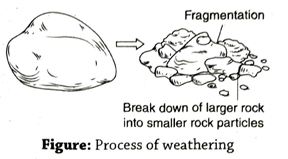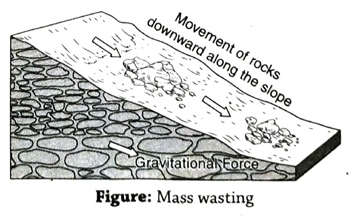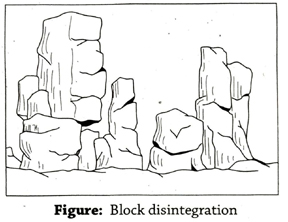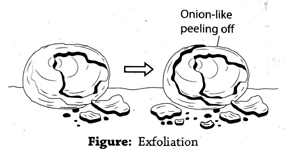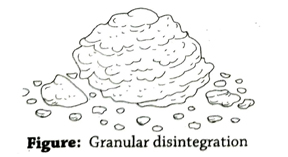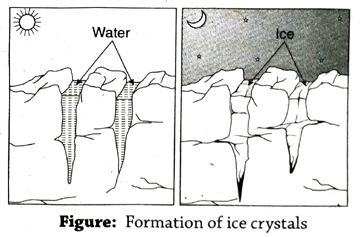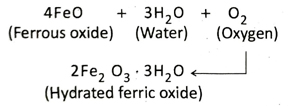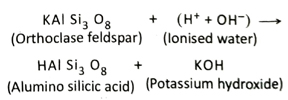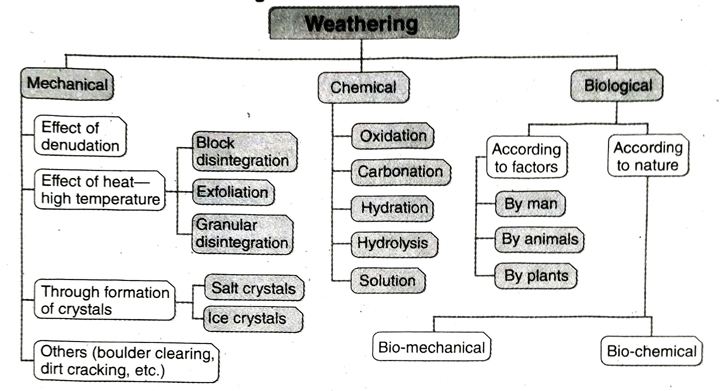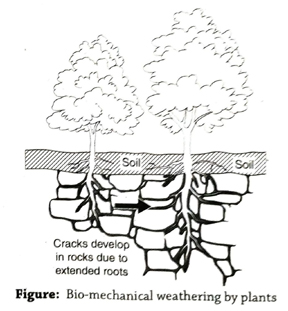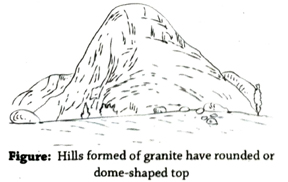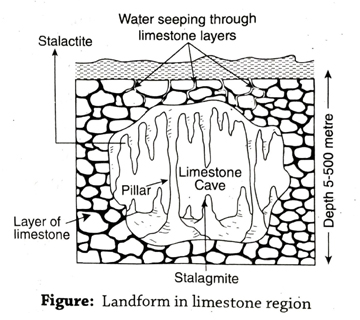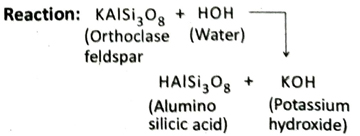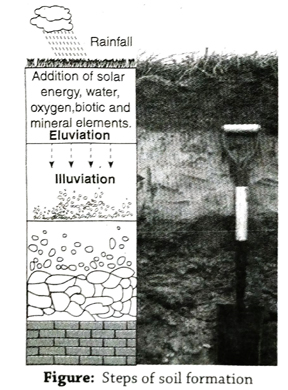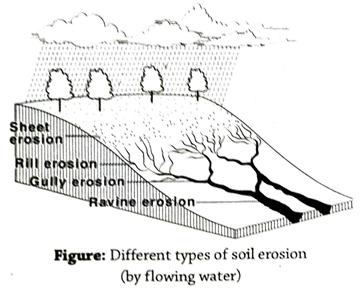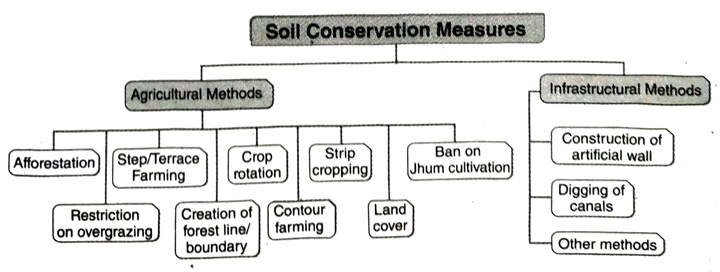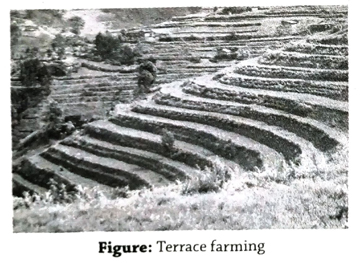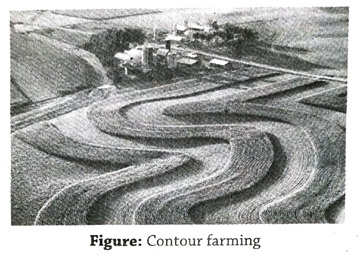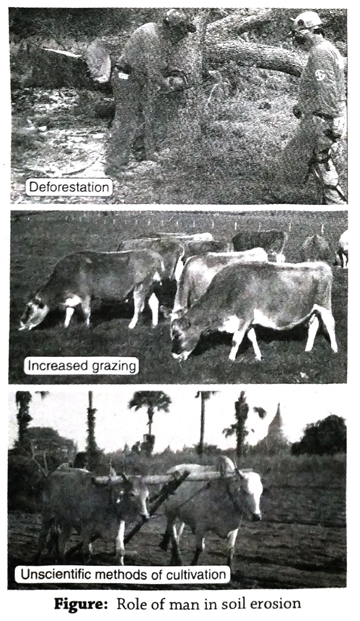WBBSE 9th Class Social Science Solutions Geography & Environment Chapter 5 Weathering
West Bengal Board 9th Class Social Science Solutions Geography & Environment Chapter 5 Weathering
WBBSE 9th Class Geography & Environment Solutions
Salient points – At a Glance
- The word weathering has been derived from the word weather.
- The term weathering was first used by geologist G. K. Gilbert.
- Weathering is a static process, i.e. disintegrated or decomposed rocks do not get removed from its original place.
- Erosion is a process whereby weathered materials are transported and deposited elsewhere by the various exogenetic forces.
- Denudation is the process in which the lower layers of the rocks are exposed through the removal of the upper layers by weathering and erosion.
- Without the effect of external or internal forces, the weathered debris of rocks move downward along the slope due to the gravitational force and are transported and deposited elsewhere. This process is known as mass wasting.
- Mechanical weathering occurs in hot desert areas, polar regions and high mountain regions.
- Exfoliation occurs in homogeneous rocks like granite.
- Block disintegration is seen more in basalt.
- Granular disintegration is prevalent more in heterogeneous rocks, i.e. rocks formed of various minerals.
- Formation of ice crystals is observed more along the foothills of the mountains in cold temperate climatic regions.
- The chemical weathering is more active in equatorial and humid-tropical climatic regions.
- Water and atmospheric oxygen react with the iron containing rocks and lead to the formation of rust on it. This process is known as oxidation.
- The process of solution is more active in rocks like chalk, limestone and dolomite, etc.
- Biological weathering is caused by various plants and animals.
- The fragmented rockwastes creating a loose covering on the Earth’s surface due to weathering, is called regolith.
- The process of soil formation from the rock debris is called pedogenesis.
- Smallest particles in the process of soil formation is called ped.
- Minerals in the upper layers of the soil mixes with rainwater and moves downwards. This is called leaching and the process is called eluviation. The process of accumulation of these particles in the lower layers is called illuviation.
TOPIC – A
Weathering and Related Processes of Weathering
Long Answer Type Questions
1. Briefly explain the concepts of erosion and denudation.
Ans. Erosion: The concept of erosion is discussed below-
- Definition: When the weathered rocks are transported from their place of origin to some other place by physical agents like rivers, glaciers, winds, etc., the process is called erosion.
- Process: The main processes of erosion include attrition, friction, plucking, removal of weathered debris, etc.
- Agent: Agents like flowing water, winds, moving glaciers, etc., transport the weathered material from one place to another.
- Characteristics: 1. Rocks are removed, 2. underlying layers of rocks are exposed after the upper layers are removed, 3. erosion is dependent on weathering, 4. it is a fast process.
Example: High velocity winds in the desert areas remove large quantities of sand and small rock fragments (by the process of erosion) to far away places.
Denudation: The concept of denudation is discussed below-
- Definition: When the lower or underlying layers of the rocks are exposed after the upper layers are removed by weathering and erosion, the process is known as denudation. The term ‘denude’ means ‘to lay bare’.
- Process: Main processes of denudation are weathering mass wasting and erosion.
- Characteristics: 1. Weathering and erosion are dependent on mass wasting. 2. This is a slow process. 3. New rocks are posed to the earth’s surface. 4. Elevation of the land is gradually decreased by the denudation processes and the uneven surface is gradually smoothened and flattened. 5. Nature of rocks, elevation of land, climate etc., effect denudation.
- Regional differences: The rate of denudation is lower in hot dry desert areas than in the high mountainous regions. In humid regions, the rate of denudation is again higher.
- Importance: Soil is formed as a result of this process and it also plays an important role in the evolution of landforms.
2. Briefly describe the concepts of weathering and mass wasting.
Ans. Weathering: The concept of weathering is as follows
- Definition: The climatic agents (e.g., temperature, rainfall, etc.) disintegrate and decompose the rocks in their own places (‘in situ’) and this process is called weathering.
- Nomenclature: As this is an alteration of the physical or chemical characteristics of rocks by various factors of weather/climate, the term weathering is pertinent.
- Factors: The factors responsible for weathering are temperature and rainfall, plant, man and other animals, nature of landforms, nature of rocks (lithological characteristics), time, etc.
- Types: Weathering can mainly be of 3 types- (1) mechanical (rocks are disintegrated or broken into fragments), (2) chemical (rocks undergo alteration in chemical composition), (3) biological (rocks are altered by the action of plants and animals).
- Process: Exfoliation, granular disintegration, hydration, oxidation, hydrolysis, etc., are the various processes of weathering.
- Characteristics: 1. Rocks are disintegrated and decomposed. 2. This is a static process. 3. The weathered materials are not removed or transported. 4. The intensity weathering depends on structure and nature of the rocks, climatic factors, etc.
- Effect: Landforms like rounded or domeshaped hills, inselbergs, tors, caves, etc., are formed. Weathering also plays a significant role in soil formation.
Mass Wasting: The process of mass wasting is discussed below-
- Definition: When the weathered materials like pebbles, boulders, etc., slide down the slopes of mountains due to gravitational pull, the process is known as mass wasting.
- Nomenclature: As the weathered rock debris are dumped at the lower slopes of the mountains after being carried there, following the natural slope or gradient (by gravitational pull), the term ‘mass’ is thus relevant.
- Factors: Slope of the land, altitude, shape, size and amount of the weathered materials, presence of vegetation, precipitation, force of gravity, etc., determine the process of mass wasting.
- Types: Mass wasting can be of 4 types- (1) slow flow, (2) rapid flow, (3) landslide, (4) subsidence.
- Process: Mud flow, soil flow, solifluction, slump, rock slide, etc., are the various processes of mass wasting.
- Characteristics: 1. This process is rampant in sloping lands. 2. The debris are removed as a result of gravitational force. 3. It can occur as a slow-or rapid process. 4. Physical agents of weathering and erosion (rivers, glaciers, etc.) do not have any role to play in the process of mass wasting.
- Effect: 1. Landslides occur in mountainous areas as a result of mass wasting. 2. These cause loss of life and property. 3. Steep slopes, erosion on slopes, talus cones, etc., are formed due to mass wasting.
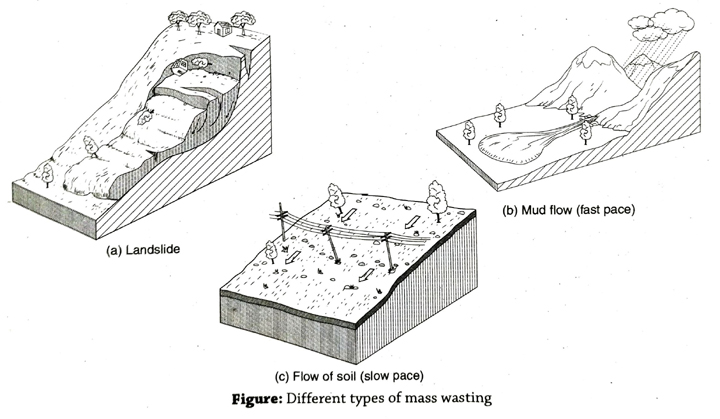
Short Explanatory Answer Type Questions
1. What are the controlling factors of weathering?
Ans. The controlling factors of weathering are as follows
- Structure of rocks: The process of weathering is accelerated in soft and jointed (with cracks and fissures) rocks.
- Relief or topography: Weathering process is more active in steep slopes of hills and plateaus.
- Climate: The different factors of climate (moisture in the air or humidity, rainfall, temperature) influence weathering to a great extent.
- Biotic factors: Roots of plants and trees, flowers, fruits, man and other animals (namely, burrowing animals), are important controlling factors of the weathering process.
2. ‘Weathering and climate are interrelated. Explain.
Ans. The interrelation between weathering and climate can be discussed if we study the following climatic regions-
- Equatorial climatic region: Temperature and rainfall are intense throughout the year in this region. Along with chemical weathering, mechanical weathering is also rampant here due to excessive heat.
- Hot and dry desert climatic region: Due to long periods of intense heat and almost negligible rainfall, mechanical weathering is predominant here. For example, exfoliation, granular disintegration, etc. are the prevalent processes.
- Cold mountainous climatic region /Arctic region: Due to excessive cold, formation of ice crystals along the cracks of rocks causes mechanical weathering.
- Tropical monsoon climatic region: Due to hot and wet climate of tropical monsoon climatic regions, both mechanical and chemical weathering are active here as a result of both heat and rain.
- Wet-temperate climatic region: In wet-temperate climatic regions, both mechanical and chemical weathering are active, mainly due to the excessive availability of moisture.
Short Answer Type Questions
1. What is weathering?
Ans. When rocks are broken down in their own places (‘in situ’) either mechanically or chemically due to the action of various elements of weather (namely temperature, rainfall, etc.) the process is known as weathering.
2. What is erosion?
Ans. When fragmented rocks are transported from their original place of weathering to some other place by various agents like rivers, glaciers, winds, etc., the process is called erosion.
3. What is denudation?
Ans. When the underlying rock layer of the earth’s surface is exposed as a result of the upper layer of rock being weathered and transported to some other place (erosion) by various agents, the process is called denudation (‘denude’ means to ‘lay bare’).
4. What is mass wasting?
Ans. When fragmented rocks, pebbles, mud, etc., slide down the slope or gradient of a mountain or a highland (as a result of gravitational force), as a mass of weathered matter, the process is called mass wasting.
5. How can mass wasting be classified?
Ans. The two main types of mass wasting are- (1) slow movement, and (2) rapid movement.
6. Why is weathering also known as the process of disintegration?
Ans. The rocks on the Earth’s surface are either disintegrated or decomposed as a result of the process of weathering and that is why it is also called a process of disintegration.
Multiple Choice Type Questions [MCQ type]
Write the correct answer from the given alternatives
1. Transportation of disintegrated rocks is known as-
A. mechanical weathering
B. chemical weathering
C. denudation
D. erosion
Ans. D
2. Movement of weathered rock materials in hilly areas is known as-
A. mechanical weathering
B. chemical weathering
C. mass movement
D. denudation
Ans. C
3. The process in which the rocks of the surface of the Earth gets disintegrated is-
A. erosion
B. denudation
C. disintegration
D. mass movement
Ans. C
4. Weathering, decomposition and removal of rocks are the combined process of-
A. disintegration
B. erosion
C. denudation
D. mass wasting
Ans. C
5. What is the order of relief developed by weathering?
A. First order
B. Second order
C. Third order
D. Fourth order
Ans. C
6. Due to weathering, rocks get-
A. deformed
B. loosened
C. eroded
D. removed
Ans. B
7. Another name of weathering is-
A. erosion
B. denudation
D. disintegration
D. none of these
Ans. C
Very Short Answer Type Questions
Fill in the blanks with suitable words
1. When the underlying rock layer is exposed to the surface, the process is called ……..
Ans. denudation
2. ……… weathering is caused by plants.
Ans. Biological
3. ……… occurs before the erosion of the rock bed.
Ans. Weathering
4. Weathering and erosion together are called ……..
Ans. denudation
5. ……… force is the cause of mass wasting.
Ans. Gravitational
6. Weathering is a ………. process.
Ans. static
If the statement is true, write ‘T’ and if false, write ‘F’ against the following
1. Disintegration of rocks by weathering is called erosion.
Ans. F
2. Denudation is a result of weathering and erosion.
Ans. T
3. Rock bed is rendered bare due to the process of denudation.
Ans. T
4. The other name weathering is rock disintegration.
Ans. F
5. Climate has great influence on the process of erosion.
Ans. T
6. Climate plays an important role in accelerating the process of weathering.
Ans. T
7. Weathering is a dynamic process.
Ans. F
Answer in one or two words
1. Where does mass wasting occur?
Ans. Mountainous area.
2. List two climatic factors responsible for weathering.
Ans. Temperature and rainfall.
3. Who was the first to use the term ‘weathering’?
Ans. G. K. Gilbert.
4. What is weathering and erosion together called?
Ans. Denudation.
5. What is of the combined process disintegration, decomposition and removal called?
Ans. Denudation.
6. What is erosion?
Ans. Removal of weathered and decomposed rock wastes by natural agents is called erosion.
TOPIC – B
Processes of Weathering
Long Answer Type Questions
1. What is meant by mechanical weathering? Describe the main processes involved.
Ans. Mechanical Weathering: The process of fragmentation or disintegration of rocks in their own places (‘in situ’) by various agents of climate like temperature, rainfall, snowfall, etc., is called mechanical or physical weathering. The rocks are broken down into smaller fragments, but the chemical compositions are unaltered.
Different processes of mechanical weathering: The various processes of mechanical weathering are
- Block disintegration: When the broken into blocks or boulders, as a result of temperature difference, the process is called block disintegration.
- Process: When there is differential heating of the outer and inner parts of rocks (the outer parts are more heated than the inner parts), there is a difference in the expansion of the components of those rocks. It is then that the vertical and horizontal cracks are formed within these rocks and they break apart along these cracks into several blocks.
- Characteristics: (a) Mostly seen in basaltic rocks, (b) several cracks are formed within the rocks both horizontally and vertically, (c) the rocks get broken in square or rectangular shapes, (d) the rocks disintegrate as big chunks or blocks.
- Occurrence: This process mostly occurs in high temperature regions.
- Exfoliation: When the layers of rocks peel off like an onion, this process is called exfoliation.
- Process: Due to differential heating and cooling of the outer and inner parts of the rocks, the upper layers come off like onion peels and are prone to further weathering.
- Characteristics: (a) Mostly seen in granitic rocks, (b) tops of highlands become rounded in shape as a result of this type of weathering, (c) this weathering occurs in homogeneous rocks.
- Occurrence: Exfoliation is most common in the hot desert regions like the Sahara and Thar deserts.
- Granular disintegration: When the rocks expand and contract alternately as a result of difference (hot and cold) in temperature, they break into smaller fragments. This process is called granular disintegration.
- Process: Rocks composed of different types of minerals absorb and release heat at varying rates and thereby do not have a uniform rate of expansion and contraction. This results in granular disintegration of these rocks.
- Characteristics: (a) This type of weathering is more common in rocks which are heterogeneous in nature. (b) When the rocks burst, sounds similar to gunshots, are heard. (c) Formation of sand is an ultimate result of such weathering process.
- Occurrence: This type of weathering is more commonly seen in hot desert regions.
- Work of ice: In cold climatic regions, rocks are broken apart by ice crystals.
- Process: In the cold Arctic region and other cold mountainous areas, the cracks in the rocks are filled up with icemelt water in the day time. This water freezes again at night due condensation (low temperature) and exerts pressure on either side of the cracks, ultimately breaking them apart.
- Characteristics: (a) Weathering occurs as a result of the formation of ice crystals. (b) Talus cones are formed on the lower slopes of mountains.
- Occurrence: This type of weathering occurs mostly in cold climatic regions.
- Other processes: Other processes of mechanical weathering include formation of salt crystals, dirt cracking, boulder clearing, hitting by raindrops, etc.
2. What is meant by chemical weathering? Explain the main processes involved in it.
Ans. Chemical weathering: The chemical composition of rocks are altered when they react with oxygen, carbon dioxide, water vapour, etc., in their own places. This process is called chemical weathering.
Different processes of chemical weathering: Different processes of chemical weathering are as follows-
- Oxidation: When the nature of minerals within a rock alters under the influence of atmospheric oxygen and water, the process is called oxidation.
- Process: In iron-bearing rocks, new minerals are formed and chemical decomposition takes place as a result of the chemical reactions in the presence of oxygen and water.
- Reaction:
- Characteristics: (a) This type of weathering takes place due to the action of water. (b) Iron-bearing rocks are subject to rusting as an effect of this. (c) Presence of oxygen is required in this type of weathering.
- Carbonation: When the nature of rocks are altered as a result of the chemical reaction of water mixed with carbon dioxide, this process is called carbonation.
- Process: When rainfall mixes with carbon dioxide in the (CO2) atmosphere, carbonic acid is formed (CO2 + H2O H2CO3). This dissolves limestone (calcium carbonate) by altering it into calcium bicarbonate (due to chemical reaction).
- Reaction:
- Characteristics: (a) This type of weathering occurs mostly due to the action of rain water. (b) It is more active in limestone rocks.
- Hydration: When water reacts with the minerals present in the rocks and alters their chemical composition, this process is called hydration.
- Process: Some minerals present in the rocks have more capacity to absorb water and they expand while undergoing chemical reactions.
- Reaction:
- Characteristics: (a) The minerals in the rocks expand. (b) As a result of absorption of water, the rocks become softer/weaker. (c) This usually occurs in homogeneous rocks.
- Hydrolysis: When the minerals present in the rocks react with ionised water, and chemical decomposition takes place, the process is known as hydrolysis.
- Process: When water reacts with the minerals in a rock, new minerals are formed, and the rock is decomposed.
- Reaction: H2O → H+ + OH–
- Characteristics: (a) It occurs in the presence of ionised or charged water. (b) New minerals are formed by this process. (c) Specific temperature is needed for reactions to occur.
Besides, due to the process of solution, gypsum, rocksalt, etc., are dissolved in water and the rocks get decomposed.
3. Classify weathering. Explain the role played by man, plants and other animals in biological weathering.
Ans.Classification of weathering:
Role of man, plants and other animals in biological weathering: Man, plants and animals biological weathering both directly and indirectly. The roles played by them are as follows-
| 1. Role of man |
Construction of buildings, roads, etc., lead to disintegration of rocks.
Cultivation of land also leads to mechanical weathering.
Mineral exploitation/mining, digging up of ponds and tanks, industrial establishments, etc., directly or indirectly cause weathering.
|
| 2. Role of plants |
When the roots of plants and trees penetrate into cracks and joints of rocks and soil, the pressure exerted upon them cause the rocks to break apart.
Parts of plants (leaves, flowers, fruits, branches, etc.) shed from trees decay and decompose, which aids in chemical weathering of rocks.
|
| 3. Role of other animals |
Burrowing animals like rabbits, rats, etc., dig holes in the ground for their survival and at the same time, fragment the rocks.
Remains of dead animals react chemically and decompose the rocks.
|
4. What is biological weathering? State the various processes of biological weathering.
Ans.Biological weathering: When rocks are disintegrated and decomposed by plants and animals, either directly or indirectly, the process is known as biological weathering. Such type of weathering occurs in almost all climatic regions.
Various processes of biological weathering: The factors of biological weathering (man, animals and plants) are actually responsible for the two main processes of biological weathering.
1. Bio-mechanical weathering:
- By animals: Burrowing animals like rats, earthworms, prairie dogs, mice, etc., dig holes in the ground to live and thereby aid in bio-mechanical weathering. Termites also help in weathering by bringing the lower layers of the soil to the upper part. Moreover, the CO₂ released by the animals living underground, brings about changes in the chemical composition of rocks and soil and aids in their weathering.
Man also has a vital role in inducing weathering. For example, carrying out mining activities, construction of roads, cultivation of lands and other unplanned activities.
- By plants: When the roots of trees and plants penetrate beneath the soil into the underlying rocks, they break the rocks into fragments. Roots can reach upto about 175 feet below the ground and thus aid in mechanical weathering. This is more prominent in areas with dense vegetation. Respiration by the roots of plants, humus, soil moisture carbon dioxide, mild temperature, etc., aids in bio-mechanical weathering of the soil.
2. Bio-chemical weathering:
- Lichens growing on rocks rot and form humus, which, in turn, is converted to humic acid after mixing with water. This aids in rapid chemical weathering of rocks.
- The organisms living in limestone rocks release CO2 with their exhalation, which combines with water to form carbonic acid. This dissolves the limestone rocks.
- The acid formed by rotting of parts of plants like leaves, flowers, fruits, branches, etc., accelerates chemical weathering. During respiration, the tree roots release CO2 which, after combining with water present in the soil, changes into carbonic acid. This eventually dissolves and disintegrates the rocks.
Short Explanatory Answer Type Questions
1. Why is mechanical weathering predominant in desert areas?
Ans.The factors responsible for the predominance of mechanical weathering in desert areas are as follows-
- Range or difference of temperature is high: The daily or diurnal range of temperature (difference of temperature between day and night) is high in desert areas. Rocks expand due to heating during daytime while they contract due to cooling at night. This results in the fragmentation and mechanical disintegration of rocks.
- Scarcity of rainfall: Chemical weathering rarely takes place due to scarcity of rainfall in the desert areas. Vegetation is also scarce due to lack of water thus, biological weathering is absent. So, only mechanical weathering plays an active part.
- Excessive denudation: Desert areas, being more prone to denudation, the upper layers of the rocks are removed by wind action and the rocks underneath are relieved from pressure. The underlying rocks expand and consequently cracks form. Subsequently, the rocks disintegrate along these cracks.
2. ‘Rainfall has an impact on mechanical weathering.’ Explain.
Ans.Rainfall influences mechanical weathering due to the following reasons-
- Formation of ice: Rainfall is responsible for the formation of ice crystals within the cracks of rocks in colder climatic regions. These crystals subsequently disintegrate the rocks.
- Raindrops hitting rocks: Raindrops hitting the rock surface over long periods ultimately leads to the fragmentation of the rocks.
- Expansion of rocks: Rain water seeping through the rock pores and layers pand the volume of the mineral constituents within them, which, in turn, leads to the breaking apart of the rocks (by mechanical weathering).
3. ‘Exfoliation is predominant in granite.’ Give reasons.
Ans.When the upper layers of the rocks come off from the underlying layers due to differential heating in homogeneous granitic areas, the process is known as exfoliation. Since the upper layers of the rock are more heated than the underlying layers, a thermal gradient is created. The heat affected upper layers of the rocks expand and come off like the layers of an onion. Exfoliation is thus a common occurrence in granite.
4. ‘The hills formed of granite have rounded or dome-shaped tops.’ Explain.
Ans. The regions having granite rocks that have high temperature or a dry, and desert type of climate, are found to have hills with rounded tops. This is because the rocks expand due to heat during the day while they contract at night when the temperature drops. This alternate heating and cooling process affects the upper layers of the rocks. Due to the alternate tension and compression, the upper layers come off from the underlying rock layers like the layers of an onion. This process is called exfoliation. The hills here are thus rendered round in shape.,
5. ‘Hot and humid climatic regions are more prone to chemical weathering. hemical wea Why?
Ans. Chemical weathering is predominant in the hot and humid climate of the equatorial and tropical regions, because of the following specific reasons-
- All the processes of chemical weatheringcarbonation, oxidation, hydration and hydrolysis require high temperature and rainfall. Both of which are abundant in the hot and humid climatic regions. In addition to this, there is also adequate water vapour in atmosphere of these regions. All of these actively help in the process of chemical weathering.
- When rainwater falls on the earth’s surface, it mixes with the CO2 present in the atmosphere and forms a mild carbonic acid. When this acid water comes in contact with limestone (calcium carbonate), it changes into calcium bicarbonate, and thus chemical weathering is initiated in the karst topography regions of the equator and tropics.
- In humid areas, the leaves, flowers, fruits, etc., shed from trees, which, on decaying, form humus and subsequently humic acid. This acid facilitates chemical decomposition of the rocks.
6. Why is chemical weathering prominent in regions having limestone rocks?
Ans.Carbonation is a process that occurs when calcium carbonate (present in limestone) reacts with CO2 in the atmosphere. When rain falls, the CO2 in the atmosphere reacts with it and turns it into mild carbonic acid. This carbonic acid reacts with calcium carbonate (limestone) to form calcium bicarbonate and ultimately dissolves the limestone.
In limestone regions, limestone is dissolved by the process of carbonation and creates a host of landform features like stalactites, stalagmites, pillars, etc.
Short Answer Type Questions
1. What are the various types of weathering?
Ans. Weathering can be of three types- (1) mechanical, (2) chemical, and (3) biological weathering.
2. What is mechanical weathering?
Ans.When different elements of weather (like temperature, rainfall, etc.) break down the rocks in their own places, this process of rock fragmentation is known as mechanical weathering.
3. Where is mechanical weathering more prevalent on the earth’s surface?
Ans. Mechanical weathering takes place mostly in high mountainous areas and in hot and dry desert regions. For example, the rocks get fragmented as a result of exfoliation, block disintegration and granular disintegration in the hot and dry desert regions.
4. Which type of landforms result from mechanical weathering?
Ans.(1) A soft layer of soil called regolith is formed due to mechanical weathering. (2) Due to exfoliation, rounded hills (especially in granite-gneiss rocks) are formed. For example, Ranchi dome near Ranchi lake in Jharkhand. (3) In cold climatic regions, angular rock fragments are formed as a result of weathering by ice and these accumulate in a cone-shaped manner in the foothill zones, and is called talus or scree.
5. Where does mechanical weathering occur due to frost or ice?
Ans.In the high mountainous areas and Arctic regions, frost or ice plays a major role in mechanical weathering. The ice in the cracks of the rocks exerts pressure on their either sides and eventually breaks the rocks.
6. What is block disintegration?
Ans.Block disintegration is a type of mechanical weathering. When the cracks in the rocks expand and contract due to differential heating (i.e., hot during daytime and cooll at night), they get weakened and eventually break apart in the form of blocks. This is called block disintegration.
7. Why is granular disintegration more prevalent in hot desert areas?
Ans.Granular disintegration is a type of mechanical weathering found in the hot and arid desert regions. Due to differential heating, the various minerals present in the rocks expand and contract alternately and these rates of expansion and contraction differ in case of different minerals. As a result, the rocks get broken down into small fragments.
8. What is exfoliation?
Ans.When the intensity of temperature is high, there is a difference of temperature in the outer and inner layers of the rocks. As a result, the outer layers of the rocks come off from the underlying layers (like onion peels). This is called exfoliation. The surface of the rock assumes a rounded shape as a result of this. Exfoliation is a common occurrence in the granite-gneiss rocks of Chota Nagpur Plateau (near Ranchi) in India.
9. Why people residing in desert areas can hear sounds similar to gunshots?
Ans.The temperature is very high in the desert areas and the rocks are heated over a long period of time during the day. However, since different minerals in the rocks have different capacities of absorbing and releasing heat, this unequal expansion and compression within the rocks exert great pressure on them and subsequently they burst, making a loud noise, that is similar to the sound of gunshots.
10. What is chemical weathering?
Ans.When rocks are subject to decomposition due to reaction with oxygen, carbon dioxide, water vapour, etc., present in the atmosphere or water, the process is known as chemical weathering.
11. In which climatic region is chemical weathering prevalent?
Ans.Due to high temperature and heavy rainfall, the equatorial regions are more prone to chemical weathering (as a result of hydrolysis, hydration, etc.).
12. Why is chemical weathering more common in the equatorial regions?
Ans.The equatorial regions experience chemical weathering because- (1) the equatorial regions have high temperature and receive rainfall throughout the year, (2) the leaves of the forests in this region fall on the ground and form humic acid, which facilitates in chemical decomposition of the rocks.
13. What is oxidation?
Ans.Chemical reaction occurs in the rocks as a result of water (in the presence of oxygen) reacting especially with iron present in the rocks. It forms oxides and hydroxides and eventually weakens and dissolves the rocks. Brownish/yellowish stains are seen on the rocks as a result of rust formation.
14. What is carbonation?
Ans.When water mixes with carbon dioxide, carbonic acid forms and it chemically reacts with calcium carbonate present in the rocks, and then dissolves the rocks. This process is known how as carbonation. This is limestones are dissolved and karst landforms are formed. For example, Borra caves near Vishakhapatnam in Andhra Pradesh.
15. What is hydration?
Ans.When the minerals present in the rocks mix with water and alter their chemical composition. This process is called hydration. This is an important process of chemical weathering.
Reaction:
Hydration actually causes granular disintegration and makes the rocks further susceptible to chemical weathering, especially by oxidation and carbonation. For example, the process of hydration changes feldspar into kaolinite clay, and the process known as kaolinisation.
16. What is hydrolysis?
Ans.The chemical combination of minerals with ionised water to form new minerals, decomposing the rock is called hydrolysis. For example, clay and silicon are byproducts of such a chemical reaction of granite. Another example is shown below-
17. Why is carbonation more predominant in limestone regions?
Ans.The process of carbonation is predominant in limestone regions because when carbon dioxide mixes with water it forms carbonic acid, and when this reacts with limestone (calcium carbonate), it forms calcium bicarbonate and dissolves the limestone.
18. What is biological weathering?
Ans.Rocks are sometimes broken down by plants and animals. Again, humic acid from decaying plants and animals results in breaking down of rocks. When the rocks are subject to change as a result of the decaying of plants and animals, the process is known as biological weathering.
19. What are the different types of biological weathering?
Ans.Biological weathering is of two types- (1) bio-mechanical weathering, and (2) bio-chemical weathering.
20. What is the role of plants in biological weathering?
Ans.(1) When the roots of plants grow and exert pressure on the cracks in the rocks, the rocks disintegrate. (2) The rotten plant remains (namely, leaves, stems/trunks, etc.) result in the formation of humic acid, which eventually dissolves the rocks.
21. What is the role of human beings in biological weathering?
Ans.(1) Rocks are broken down into fragments as a result of agricultural practices, mining activities, etc. (2) Rocks are disintegrated and dissolved as a result of construction of houses, roads, excavation of canals, etc.
22. What is colloid plucking?
Ans. The wet soil particles or colloids that form on the rocks, dry up eventually and exert pressure on the minerals present in the rocks. This results in weathering of rocks and this process is called colloid plucking.
23. Why does rust form on rocks?
Ans. The iron-bearing minerals present in certain rocks are prone to the formation of rust. The process of oxidation converts the ferrous oxide present in the rocks into ferric acid, which results in the formation of light brown and yellow coloured rust.
24. What is desert-varnish?
Ans. In the desert areas, the orangish-yellow coloured coating that forms on the rock layers is called desert-varnish. It is composed of clay, iron and manganese oxide. They are found mostly in basalt and quartzite rocks.
25. What is slaking?
Ans. Slaking is the process of alternate wetting and drying of rocks. In coastal region rocks gradually get wet and dry twice a day due to tide action. Consequent expansion and contraction of rock shells result in disintegration of rocks. Slaking is common in clayey alluvial soil.
26. What is chelation?
Ans. Chelation is the process where organic acid reacts with a insoluble mineral and transforms it into a soluble mineral. Podsol soil is formed by the chelation process in coniferous forest region.
27. What is sheeting?
Ans. Sheeting is a process in which cracks and fractures develop parallel to ground surface in massive rocks such as granites, quartzites etc. Main cause of sheeting is removal of superincumbent load that results in reduction of pressure off the rock layers.
28. What is spalling?
Ans. Spalling is a common mechanism of rock weathering. In this process cracks and fractures develop and lozenge or irregular platy rock fragments form. Main causes of spalling are unloading of superincumbent load, freezing and thawing and thermal expansion.
Multiple Choice Type Questions [MCQ type]
Write the correct answer from the given alternatives
1. The main process of mechanical weathering in a warm desert is-
A. saline crystal formation
B. frost action
C. granular disintegration
D. block disintegration
Ans. C
2. Which component plays an important role in the oxidation process of the weathering of rocks?
A. H2
B. O2
C. N2
D CO2
Ans. B
3. The main component of chemical weathering is –
A. water
B. sunlight
C. air stream
D. flora
Ans. A
4. Chemical formula of humic acid is-
A. C12H186O89N9S1
B. C10H20O10
C. C12H20O10
D. C5H6O7
Ans. A
5. Limestone clad areas are prone to-
A. carbonation
B. hydration
C. hydrolysis
D. oxidation
Ans. A
6. Snowfall prone areas experience-
A. mechanical weathering
B. chemical weathering
C. biological weathering
D. mechanical and chemical weathering
Ans. A
7. Which of the following is visible in homogeneous rocks?
A. block disintegration
B. exfoliation
C. granular disintegration
D. biological weathering
Ans. B
8. Rusting of rocks due to chemical weathering is known as-
A. oxidation
B. carbonation
C. solution
D. hydrolysis
Ans. A
9. Areas which are prone to chemical weathering are-
A. tundra areas
B. cool temperate areas
C. equatorial areas
D. semi-arid areas
Ans. C
10. Exfoliation occurs in-
A. basalt
B. granite
C. sandstone
D. all types of rocks
Ans. B
11. The process of mechanical weathering which is most effective in high altitude areas or cold areas is-
A. colloid plucking
B. bolder cleaving
C. frost action
D. sheeting
Ans. C
12. The kind of weathering that takes place in heterogeneous rocks is-
A. disintegration
B. boulder cleaving
C. exfoliation
D. granular disintegration
Ans. D
13. When water freezes into ice, its volume-
A. decreases by 8 %
B. increases by 9 %
C. increases by 10 %
D. decreases by 11 %
Ans. B
14. Heavy rainfall prone tropical areas witness-
A. mechanical weathering
B. chemical weathering
C. biological weathering
D. none of the above
Ans. B
15. Result of mechanical weathering in rocks is-
A. physical change
B. chemical change
C. both physical and chemical change
D. no changes occur
Ans. A
16. The process in which calcium carbonate transforms into calcium bicarbonate is-
A. oxidation
B. carbonation
C. hydrolysis
D. solution
Ans. B
Very Short Answer Type Questions
Write the correct answer from the given alternatives
1. Rock disintegration takes place in ………. type of weathering.
Ans. mechanical
2. Oxidation is a type of ……….. weathering.
Ans. chemical
3. Decomposition occurs in ………… weathering.
Ans. chemical
4. Exfoliation is commonly found in ………. areas.
Ans. desert
5. Limestone gets dissolved as a result of ……….
Ans. carbonation
6. Rocks containing iron forms rust as a result of ………..
Ans. oxidation
7. In areas of snowfall, ……… weathering largely occurs.
Ans. mechanical
8. In tropical regions, ………. weathering is largely seen.
Ans. chemical
9. Carbon dioxide mixed with water forms ………. acid.
Ans. carbonic
10. The constituents of rocks are not altered in case of ………. weathering.
Ans. mechanical
11. In cold climatic regions, ……….. is the process of mechanical weathering.
Ans. frost action
12. In heterogeneous rocks, …….. takes place.
Ans. granular disintegration
13. Rocks change only in shape in case of ………. weathering.
Ans. mechanical
14. Weathering does not occur in ……….. areas.
Ans. permafrost
15. In limestone regions, process of solution creates ……… topography.
Ans. karst
16. Mechanical weathering due to salt crystals occurs largely in……….
Ans. sandstone
17. …….. cause biotic weathering through agriculture.
Ans. Humans
18. Granular disintegration occurs in ………. rocks.
Ans. heterogeneous
19. When water changes into ice, its volume …………
Ans. increases
20. Weathering is a ……….. process.
Ans. slow
21. Due to the process of hydration hematite transforms into …………
Ans. limonite
22. Granular disintegration is an example of ……….. weathering.
Ans. mechanical
23. The chemical weathering that occurs due to the reaction of carbon dioxide is called ………
Ans. carbonation
If the statement is true, write ‘T’ and if false, write ‘F’ against the following
1. Mechanical weathering is dominant in tropical climate.
Ans. F
2. Carbonic acid helps in oxidation.
Ans. F
3. Chelation is a type of bio-chemical weathering.
Ans. T
4. Solution is a process of mechanical weathering.
Ans. F
5. Rocks become smooth and circular as a result of exfoliation.
Ans. T
6. Rusting of rocks occurs due to the process of carbonation.
Ans. F
7. The characteristics of a rock remain unchanged in chemical weathering.
Ans. F
8. Atmosphere is the main component of weathering.
Ans. F
9. Rainfall during monsoon helps in mechanical weathering.
Ans. T
10. Granular disintegration occurs silently.
Ans. F
11. Chemical weathering is dominant in desert climate.
Ans. F
12. Mechanical weathering changes mineral composition of original rocks.
Ans. F
13. Burrowing animals like rats, rabbits, earthworms, etc. cause mechanical weathering.
Ans. F
Answer in one or two words
1. Where does granular disintegration take place?
Ans. Desert area.
2. Which gaseous component is needed in oxidation?
Ans. Oxygen.
3. What is the process of combination of rock minerals with water called?
Ans. Hydration.
4. Which type of weathering results in rusting of rocks?
Ans. Oxidation.
5. Name a burrowing animal.
Ans. Rat.
6. Exfoliation occurs in which rock?
Ans. Granite.
7. Which type of weathering occurs due to construction of houses and roads?
Ans. Mechanical weathering.
8. Ice disintegration occurs in which climatic region?
Ans. Tundra.
9. Which type of weathering causes changes in the structural composition of rocks?
Ans. Chemical weathering.
TOPIC – C
Effect of Weathering and Soil Erosion
Long Answer Type Questions
1. State the effects of weathering. Explain how soil is formed as a result of weathering.
Ans. Effects of weathering: The effects of weathering are-
- Formation of landforms: Landforms like tors and rounded hills in the humid tropical regions, inselbergs in the hot dry desert regions, caves, stalactites and stalagmites in limestone areas, etc., are all formed as a result of weathering.
- Formation of minerals: New minerals are formed as a result of chemical reactions. For example, bauxite is formed in humid tropical countries.
- Facilitates agriculture: Due to disintegration of rocks by weathering, the porosity of soil increases, which facilitates air and water circulation and hence aids in agricultural practices.
- Formation of regolith: Due to the disintegration and decomposition of rocks, regolith is formed, which plays a major rule in soil formation later on.
Soil Formation: The soil forming process, as a result of weathering, may be explained by the following stages-
- First stage: Various processes of mechanical, chemical and biological weathering, break down rocks into smaller fragments and decompose them further. This loose layer of fragmented rocks on the top is called regolith, which is the first step of soil formation.
- Second stage: Rain water and air seeps through the various layers of the rocks through these regolith layer which facilitates chemical weathering of the fragmented rocks. Biological weathering is also initiated by the micro organisms and the dead remains of plants and animals present in the top layer. As a result a black coloured substance called humus forms through the process of humification.
- Third stage: Humus and other weathered particles oxidise in the presence of oxygen and form new minerals. This process is called mineralisation. During the process of soil formation iron, aluminium and other minerals transport from the top layer to the lower layers of the soil. This process is called eluviation. These minerals get accumulated in the lower layers and this process is called illuviation.
Thus, with the passage of time the components in the soil forming process change their physical and chemical characteristics to form a soft layer called soil on the surface of the Earth, with organic matter and minerals as its constituents.
2. Briefly explain the concept of soil erosion.
Ans. Concept of soil erosion: The concept of soil erosion is-
Definition: The process in which soil particles are removed from the top layer by natural or man-made factors, is called soil erosion.
Factors: The following equation explains the process-
e = g(cl, v, t, s, h)
where, e = soil erosion, g = effectiveness, cl= climate, v = vegetative cover, t = landform or relief, s = type of soil, h = role of man or human interference.
Causes of soil erosion: They may be classified as-natural and man-made causes.
- Natural causes:
- Rainfall: In regions with high rainfall, the raindrops loosen the soil particles from the rock layer and wash them away.
- Wind: Winds blow with high velocity in open desert areas and coastal tracts (receiving no obstacles) and lead to soil erosion.
- Flowing water: Currents of river water and sea waves over the adjacent land areas cause soil erosion.
- Man-made causes:
- Deforestation: In deforested areas, the bare land is more prone to soil erosion. The roots of the trees bind the soil together. When the trees are cut down, the region becomes prone to soil erosion and is thus rendered infertile.
- Overgrazing: Excessive grazing by cattle, goats and sheep in grassland areas results in the baring of the ground, leading to soil erosion.
- Unscientific methods of cultivation: In areas where shifting or ‘jhum’ cultivation is practised, the forest is cleared by burning it down (which is unscientific), and this leads to soil erosion.
Process of soil erosion: Soil erosion is mainly caused by flowing water and wind.
- By work of flowing water:
- Sheet erosion: When rainfall or flowing water removes the soil layer by layer, it is known as sheet erosion.
- Rill erosion: When rainwater or a river (in its youth stage), flows along the slopes of a mountain as narrow channels or rills, soil erosion occurs.
- Gully erosion: These rills become wider and deeper due to more soil erosion, and this is known as gully erosion.
- Ravine erosion: When the gullies become further deepened and widened, the topography is converted to a ‘badland’, where cultivation is not possible and the area becomes inaccessible too.
- By work of wind: In the desert areas, winds carry sand from one area to other distant areas, leading to erosion of the top layer.
Effects of soil erosion:
- Effects on physical environment: (a) As a result of soil erosion, the groundwater level decreases, (b) hydrological cycle is affected, (c) food chain is disturbed as habitats of the decomposers (like bacteria, fungi, etc.) present in the soil are destroyed, (d) the navigability of rivers and other waterbodies decrease (due to aggradation by soil deposits or siltation), and the areas become more prone to floods.
- Effects on human environment: (a) Fertility of soil decreases, crop productivity gets reduced, (b) decrease in navigability of rivers hampers trade and water transport, (c) ecosystem of wetlands is damaged as they get filled up with soil deposits.
Areas prone to soil erosion: Continuous flat areas, plateaus devoid of vegetation, desert areas, coastal areas, riverine tracts, etc., are more prone to soil erosion.
3. Briefly discuss the methods of soil conservation.
Or, Discuss the preventive measures for soil erosion.
Ans. Different methods of soil conservation: The various measures adapted for preventing soil erosion and for increasing the fertility of the soil are known as soil conservation measures.
1. Agricultural methods:
- Afforestation: If trees are planted along the slopes of mountains, on infertile and barren lands, soil erosion can be prevented. This is because the roots of the trees bind the soil together.
- Restriction on overgrazing: If overgrazing can be controlled in the grassland areas, soil erosion can be prevented.
- Ban on shifting or jhum’ cultivation: When the forests are burnt down for clearing land, the trees are destroyed and soil erosion also increases. This can only be prevented by banning such a practice.
- Step/Terrace farming: The slopes of the mountains are carved into steps or terraces to retain rainwater on each step (to be used by the cultivated crops). Soil erosion can be prevented by practising such type of farming.
- Creation of forest line/boundary: If forest boundaries are created (by planting trees) on all sides of agricultural fields, coastal regions (especially in the direction of the winds), etc., then soil erosion can be reduced.
- Crop rotation: If any land is cultivated throughout the year with different types of crops (not allowing it to lay bare), then the land is not exposed to soil erosion.
- Contour farming: Bunds are constructed along the contour of the land (horizontally along the slopes of mountains), to prevent water from washing down and hence it prevents soil erosion.
- Strip cropping: When crops are cultivated in long strips prepared along the slopes, they prevent soil from being carried away by flowing water along the slopes.
- Land cover: If the unused parts of the crops like stems, hay, etc., are spread over any bare land, soil erosion can be prevented, especially in muddy areas.
2. Infrastructural methods:
- Construction of artificial walls: If walls are constructed on seashores and along river banks, soil erosion by flowing water can be prevented.
- Digging of canals: If canals are dug to facilitate drainage and several waterbodies are constructed especially in the desert areas, soil erosion can be prevented.
- Other methods: More advanced research on preventing soil erosion and increasing soil fertility, spreading awareness among the people, can help in soil conservation.
Short Explanatory Answer Type Questions
1. What is the role of man in soil erosion?
Ans. The activities carried out by human beings that lead to soil erosion, are as follows-
- Deforestation: Due to cutting down of trees, the soil is exposed to weathering. Thus rainwater washes away the fertile topsoil.
- Unscientific methods of cultivation: Shifting cultivation, intensive cultivation, etc., reduce soil fertility and increase soil erosion.
- Increased grazing: Excessive grazing practised on the thin soil along the mountain slopes, leads to exposure of the soil to weathering and erosion.
2. How does terrace farming help in conserving soil?
Ans. The rate of flow of water along the slopes of hills and mountains can be controlled. In such areas, farming is done on steps cut along the slopes at different heights. Each step or terrace is bordered by slightly elevated mud bunds which prevent washing away of water down the slope and thus stores water on these terraces. Thus, run off is reduced and infiltration of water underground is increased. These terraces are of three types-
- Bench-like steps: The lower part of these steps are flat and on the outer sides, low bunds are constructed.
- Successive steps: A series of steps or terraces at different altitudes (like a staircase), prevents water from washing down and thus conserves soil.
- Plain or flat steps: The lower part of these steps are flat and different crops are cultivated here. Thus, water seeps underground and soil erosion is prevented because run-off is controlled.
3. How does weathering help in increasing soil fertility?
Ans. The role of weathering in increasing soil fertility is discussed as follows-
- A soft layer called regolith is formed on the upper surface of the Earth as a result of weathering. The minerals present in this regolith seep underground (in solution with water) and supply essential nutrients to the plants.
- The roots of trees cause the rocks to break apart (biotic or biological weathering). Besides, burrowing animals like rabbits, rats, etc., loosen up the soil by digging into it and thereby allow air circulation in soil, which is beneficial to the plants.
- Humus is formed as a result of decaying of leaves, flowers, etc., that are shed from the trees. When humus mixes with the oxygen present in the atmosphere, it enriches the various minerals found in the soil, which, in turn, increase the fertility of the soil.
4. What are the landforms developed due to the weathering?
Ans. Weathering is a process in which surface rocks are disintegrated or decomposed and remain in its original place or ‘in situ’. Weathered materials are transported through the process of erosion. So, the process of weathering and erosion together develop various types of landforms, namely-
- Round shaped topography develops over granite by the process of exfoliation;
- flattened topography develops on basalt by the process of block disintegration;
- residual hills like inselbergs form in the hot deserts. Sometimes, these are transformed in mesas, buttes due to excessive weathering and erosion;
- in humid tropical climate, tors develop;
- in limestone regions, caves, stalactites, stalagmites etc. form due to carbonation and solution processes. Sometimes, rivers that flows over a karst region may disappear and enters underground through shallow holes or sink holes which develop blind or dry valleys on the surface.
- Felsenmeer forms through deposition of talus or scree along the foothills.
Short Answer Type Questions
1. What is soil erosion?
Ans. When soil particles from the top layer are separated and transported elsewhere due to natural or man-made factors, it is called soil erosion. For example, soil erosion occurs as a result of surface run-off due to heavy rainfall (the top soil is washed off and transported elsewhere).
2. Where is terrace farming practiced?
Ans. Terrace farming (or step farming) is usually practiced along the slopes of mountains. For example, it is common in the hill slopes of Darjeeling.
3. What is talus?
Ans. Action of ice and snow in the cold mountainous regions, widens the cracks in the rocks and eventually breaks the rocks into angular fragments. These fragments are deposited at the foothill zones in a conelike formation known as talus or scree. These features are commonly seen in the Ladakh region. They are also known as Blackspade or Felsenmeer.
4. What is humification?
Ans. The process by which the organic matter present in the soil is decomposed by microorganisms and turned into a black coloured semi-solid substance, is called humification.
5. What is eluviation and illuviation?
Ans. The process by which the dissolved minerals in the upper layers of the soil are transferred to the lower layers is called eluviation.
The process in which the minerals present in the soil are deposited in the lower layers of the soil/rocks is known as illuviation.
6. What is terra rosa?
Ans. In the karst region, the dissolved limestone gets removed and accumulated in the upper layers of the soil as a result of the process of carbonation. This red coloured layer of soil deposited on the earth’s surface is called terra rosa (‘terra’ meaning soil and ‘rosa’ meaning red).
7. What is regolith?
Ans. The layer formed of disintegrated and decomposed rock particles lying on the upper layers of the earth’s surface is called regolith. The soil-forming process starts from the formation of regolith (a slow process).
8. What is solum?
Ans. The humus-rich layer formed in the process of soil formation lying on the parent rock is called solum. The term ‘soil’ is derived from the Latin word ‘solum’.
9. What are tors?
Ans. Due to differential weathering, the hard inner layers of the rocks are exposed to the surface when the surrounding soft regolith gets removed. Sometimes the rocks that have broken apart along the points or cracks may tumble down the slope of hills. The remaining upright hard rocks situated on the slopes or in the foothills of gently sloping hills are called tors.
10. What is humus?
Ans. Dead plant, animal remains, fallen leaves, flowers, fruits, etc. get deposited on the regolith layer as raw organic matter. The organic matter is decomposed by microorganisms and turned into deep brown or black coloured complex matter. This complex matter is known as humus. The soil that is rich in humus is fertile in nature. Water holding capacity of humús-rich soil is greater.
Multiple Choice Type Questions [MCQ type]
Write the correct answer from the given alternatives
1. The first stage of soil formation is-
A. solum
B. regolith
C. batholith
D. monolith
Ans. B
2. Conical rocks formed due to frost action-
A. talus or scree
B. erg
C. pediment
D. bajada
Ans. A
3. Terrace farming is prevalent in-
A. hilly areas
B. deserts
C. plain areas
D. coastal areas
Ans. A
4. Soil erosion in desert areas takes place-
A. due to river action
B. due to glacial action
C. due to wind action
D. due to human beings
Ans. C
5. Layer of soil formed due to weathering in limestone regions is called-
A. terra rosa
B. talus
C. blocksped
D. pediment
Ans. A
6. The process of humus formation is called-
A. regolith
B. humification
C mineralisation
D. alluviation
Ans. B
7. Which process of weathering leads to the formation of karst landforms?
A. oxidation
B. carbonation
C. hydrolysis
D. block disintegration
Ans. B
8. One of the man-made reasons of soil erosion is-
A. water flow
B. farming
C. extension of root
D. digging holes in soil
Ans. B
9. The process of weathering that forms inselbergs is known as-
A. exfoliation
B. carbonation
C. hydrolysis
D. oxidation
Ans. A
10. The layer of disintegrated rock particles that is formed due to weathering is known as-
A. hardpan
B. batholith
C. regolith
D. lopolith
Ans. C
11. Covering the land by straw, root of the crops, etc. is a process of soil conservation, which is called-
A. mulching
B. terracing
C. strip cropping
D. contour cropping
Ans. A
12. The process that results in removal of minerals from the upper layer of soil, is-
A. humification
B. mineralisation
C. calcification
D. eluviation
Ans. D
13. …….. forms due to weathering.
A. Mountain
B. Plateau
C. Soil
D. Desert
Ans. C
14. Maximum eluviation occurs in-
A. desert areas
B. cold areas
C. rainy areas
D. temperate areas
Ans. C
Very Short Answer Type Questions
Fill in the blanks with suitable words
1. The layer of loose and unconsolidated materials lying over the bedrock is called ………
Ans. regolith
2. The most important effect of weathering is the formation of ……….
Ans. soil
3. ………. cultivation should be practised on hill slopes in order to prevent soil erosion.
Ans. Step
4. Deposition of ………. helps in the weathering of rock beds,
Ans. groundwater
5. The erosion of soil by raindrops is a ………. cause.
Ans. natural
If the statement is true, write ‘T’ and if false, write ‘F’ against the following
1. Weathering helps in the storage of ground water in the rock beds.
Ans. T
2. The disintegrated layer of the rocks as a result of weathering is called regolith.
Ans. T
3. Rock particles formed by the disintegration due to ice crystals are called boulders.
Ans. F
4. Regolith is formed in the last stage of soil formation.
Ans. F
5. An important influence of weathering is the formation of soil.
Ans. T
6. Afforestation controls soil erosion.
Ans. T
7. Weathering helps in increasing soil fertility.
Ans. T
8. Soil erosion increases due to the excesive grazing.
Ans. T
Answer in one or two words
1. What is the loose and thin layer of finely fragmented rocks due to weathering known as?
Ans. Regolith.
2. In the process of soil formation, when the minerals present in the regolith are removed from the upper to lower layers, what is this process known as?
Ans. Eluviation.
3. What is the process called by which humus is formed?
Ans. Humification.
4. When weathering occurs as a natural process, what is it called?
Ans. Geomorphic weathering.
5. What is the process called by which the depth of gullies increases due to erosion?
Ans. Gully erosion.
6. How can the soil in the slopes of mountains be conserved?
Ans. By terrace farming.
7. What is the process of conserving soil by covering it with a layer of organic material called?
Ans. Mulching.
